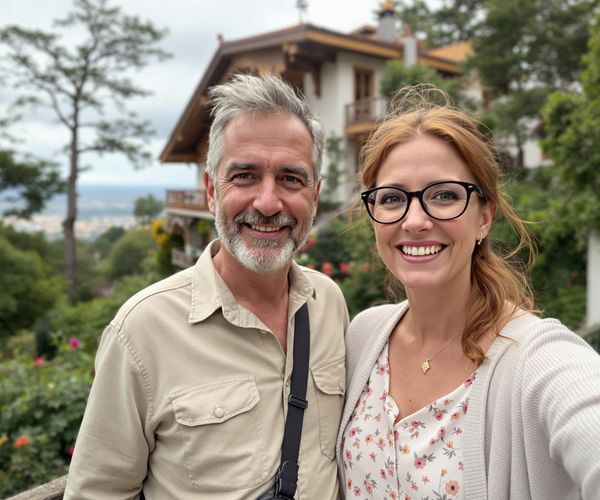Private Tour Sintra, Cabo da Roca, Cascais e Estoril
Highlights
- Explore the enchanting Pena Palace in Sintra
- Discover the historic village of Sintra and its charming streets
- Visit the iconic Cabo da Roca, the westernmost point of Europe
- Experience the mystical Quinta da Regaleira and its beautiful gardens
- Relax on the stunning Guincho Beach or Cascais coastline
-
Private tour
-
Duration 8-9 hours
-
Hotel pickup and drop-off
-
Transport by air-conditioned vehicle
-
Expert guide in multiple languages
-
Bottled water included
Experience the wonders of Sintra, Portugal with this private tour that takes you to all the must-see sights in the area. Explore the enchanting Park and National Palace of Pena, a stunning example of romantic revival architecture, and immerse yourself in the history and beauty of Centro Historico de Sintra. Visit the Sintra National Palace, with its rich Moorish connections and intricate tile work. Discover the magical Quinta da Regaleira, a monument shrouded in mystery and symbolism. Stand at Cabo da Roca, the westernmost point of mainland Europe, and marvel at the breathtaking views. Relax on the picturesque Guincho Beach, and wander through the charming town of Cascais with its elegant stores and beautiful beaches. End your tour in the glamorous resort of Estoril, where you can enjoy the vibrant nightlife and soak in the luxurious atmosphere. This private tour offers a truly unforgettable experience of Sintra and its surrounding areas.
At a Glance
-
Free cancellation
-
8 hours
-
Instant Confirmation
-
Available in English, French, Portuguese, Spanish; Castilian
-
Mobile voucher
-
Private Tour
-
Guided
-
Family friendly
Featured Reviews
Explore the stunning landscapes of Sintra, Cabo da Roca, Cascais and Estoril on a private tour with expert guidance and comfortable transport.
Included
-
Hotel pickup and drop-off
-
Driver/escort
-
Transport by air-conditioned vehicle
-
Private tour
-
Bottled water
Excluded
-
Entrance tickets
-
Food and drinks
-
Gratuities
-
Lunch
Pickup
Check if pick-up is available from your location, you will select during checkout (providers may allow other pickup locations)
What to expect
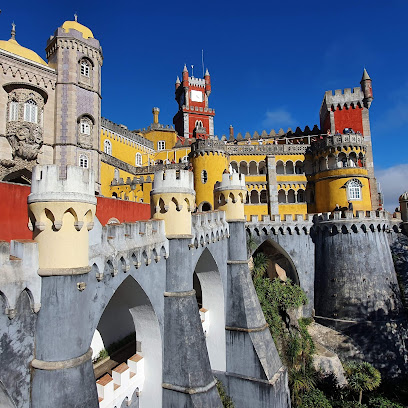
The fantastic Pena Palace is one of the greatest examples of the romantic revival of the century. XIX in Portugal. Located in Monte da Pena, the Palace was built on the site of an old convent of friars of the Order of São Jerónimo. It was the result of the imagination of D. Fernando de Saxe Coburgo-Gotha, who married Queen D. Maria II in 1836. In love with Sintra, he decided to acquire the convent and the surrounding lands to build the summer palace of the royal family. The consort king adopted Portuguese architectural and decorative forms for the palace, in the revivalist style (neo-gothic, neo-manueline, neo-islamic, neo-renaissance) and in the surroundings he decided to make a magnificent English-style park, with the most varied tree species exotic. Inside, still decorated to the taste of the kings who lived there, the chapel stands out, where you can see a magnificent alabaster marble altarpiece attributed to Nicolau Chanterenne (one of the architects of the Jerónimos Monastery, in Lisbon). Also worthy of mention are the mural paintings in trompe l'oeil and the tile coverings.
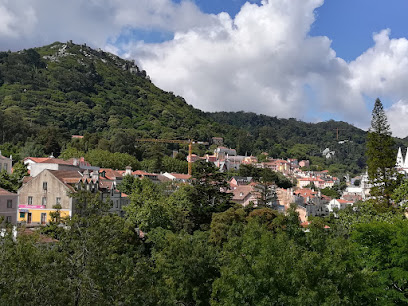
Time to stroll through the narrow streets of the village of Sintra and take the opportunity to taste its conventual confectionery. The following are two options for viewing: 1 - National Palace; 2 - Quinta da Regaleira A beautiful town at the foot of the mountain range of the same name, its unique characteristics have led UNESCO to classify it as a World heritage site. It was even necessary to create a special category for the purpose - that of "cultural landscape" - taking into account its natural riches as well as the historic buildings in the town and mountains. Endowed with luxuriant vegetation, the mountains are part of the Sintra-Cascais Natural Park. From early times Sintra has been the place of choice for the settlement of various peoples who have passed through the Iberian Peninsula and left traces of their presence, which are now displayed in the Archaeological Museum of Odrinhas, in the outskirts of the town. In the 12th century, Dom Afonso Henriques, the first King of Portugal, captured the Moorish Castle, and his successors later built their holiday residence. Their physiognomy is marked by the two enormous conical chimneys built in the Middle Ages. Much appreciated by kings and nobles as a country resort, and praised by writers and poets like (inevitably) Lord Byron who called it "glorious Eden", Sintra has a wealth of cottages and manor houses, some of which now provide accommodation in the form of country-house tourism. The palaces, too, are outstanding, such as the Pena Palace, built in the Romantic period on one of the mountain peaks, and the 18th century Palace of Seteais, now converted into an elegant hotel, and the Palace of Monserrate, famous for its beautiful gardens with their exotic species that are unique in the country. Sintra's confectionery deserves a special mention, particularly the travesseiros (puff pastes stuffed with a sweet eggy mixture) and the famous cheese-cakes, which according to ancient documents were already being made in the 12th century, and were part of the rent payments. Near Sintra are the beaches (das Maças, Praia Grande, Praia da Adraga), Cabo da Roca (the westernmost point of mainland Europe), Colares (after which a demarcated wine-growing region is named), and the picturesque village of Azenhas do Mar, inset in a cliff.
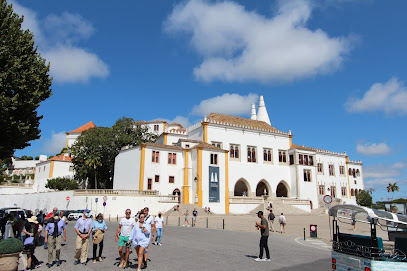
The ancient history of Paço da Vila de Sintra begins during the Muslim rule in the Iberian Peninsula. Already mentioned in the 11th century, the primitive Moorish palace - owned by the Portuguese crown after the conquest of Lisbon by D. Afonso Henriques (1147), 1st King of Portugal - is intervened for the first time in 1281, during the reign of D. Dinis. New construction bodies are added over time, under the reigns of D. Dinis, D. João I and D. Manuel I, maintaining their silhouette since the middle of the 16th century. The arrangement of spaces in height, adapting to the terrain; the intimate organization of the indoor open air patios, where you can hear the water running; its windows with outdated arches; and the tile coverings of rich geometric patterns, show the Moorish connection of the craftsmen who built and embellished the Palace.
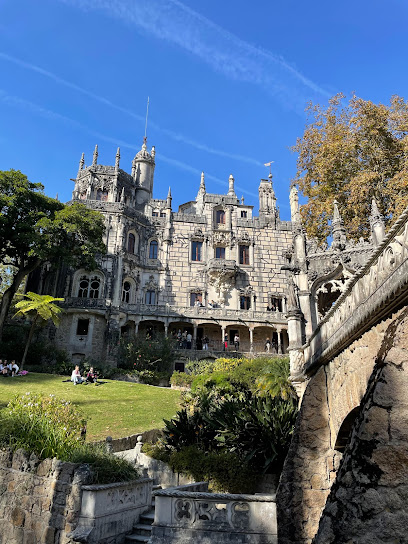
Quinta da Regaleira is one of the most amazing monuments in the Serra de Sintra. Located at the end of the historic center of the village, it was built between 1904 and 1910, in the last period of the monarchy. The romantic domains formerly belonging to Viscondessa da Regaleira, were acquired and expanded by Dr. António Augusto Carvalho Monteiro (1848-1920) to found his place of choice. Holder of a prodigious fortune, which earned him the nickname Monteiro dos Milhões, he associated with his unique architecture and landscape project the creative genius of the Italian architect and scenographer Luigi Manini (1848-1936) as well as the mastery of sculptors, stonemasons and carvers who had worked with him at the Palace Hotel in Buçaco. A man of scientific spirit, a vast culture and rare sensitivity, a remarkable bibliophile, a discerning collector and a great philanthropist, he left in this stone book the vision of a cosmology, a synthesis of the spiritual memory of humanity, whose roots immerse themselves in the Lusa and Universal Mythic Tradition. The architecture and art of the palace, chapel and other buildings were designed in the context of an Edenic garden, highlighting the predominance of neo-Manueline and Renaissance styles. The garden, a representation of the microcosm, is revealed by the succession of places imbued with magic and mystery. Paradise is materialized in coexistence with an inferius - a Dantesque underground world - to which the neophyte would be led by Ariadne's thread of initiation. With these scenarios, the representation of an initiatory journey, like vera peregrinatio mundi, through a symbolic garden where we can feel the Harmony of the Spheres and examine the alignment of an asceticism of consciousness that travels through the great epics, materializes. In it are glimpsed references to mythology, Olympus, Virgil, Dante, Camões, the Templar mission of the Order of Christ, great mystics and thaumaturges, the enigmas of Real Art, the Magical Work of Alchemy. In this stone symphony, the poetic and prophetic dimension of a Portuguese Philosopher's Mansion is revealed. Here Heaven and Earth merge in a sensitive reality, the same that presided over the theory of the Beautiful, of Architecture and of Music, that the acoustic shell of the Terrace of the Celestial Worlds allows to propagate for the infinite.
Cabo da Roca
Cabo da Roca is the westernmost point of the European continent or, as Luís Vaz de Camões wrote, the place “Where the Earth ends and the sea begins” (in Os Lusíadas, Canto VIII). A stone pattern with a headstone marks this geographical feature to all who visit this place. Cabo da Roca is also called “Focinho da Roca” by people linked to things of the sea, and more poetically by “Promontório da Lua”, It is integrated in the Sintra Cascais Natural Park, which encompasses a vast area of natural interest and beauty landscape from Cascais Citadel to the mouth of the Falcão River. From Cabo da Roca it is possible to follow several eco-trails. In Cabo da Roca, the visitor is faced with a spectacular landscape, an imposing lighthouse and various infrastructures. It is also in this place that one of the rarest plant species is found, the "armeria pseudoarmeria". Being located in an area with easy access and a large number of tourists, many people visit it.
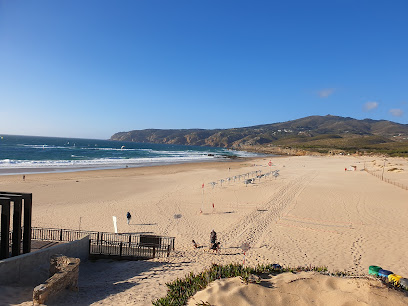
In the vicinity of Cascais, the extensive sandy beach of Praia do Guincho is very popular with swimmers during the summer season and all year round for surfers and windsurfers, sports for which this beach offers excellent conditions. Along the road by the sea, countless restaurants of excellent quality offer excellent dishes of fresh fish and seafood.
Cascais
Located by the sea and traditionally a fishing village, Cascais had an important development in the 19th century. XIV, when it was a busy port of call for ships heading for Lisbon. However, it was from the 2nd half of the century. XIX, when the sea baths began to be appreciated, that Cascais suffered an impulse that transformed it into a very fashionable summer resort. The main driver of the transformation was the King of Portugal D. Luís I, who in 1870 converted the citadel fortress into the summer residence of the Portuguese monarchy. This example was followed by the nobility who built mansions and beautiful houses where the hottest time of the year was spent, completely transforming the old fishing village. Cascais also started to attract strollers, whose access was made easier by the inauguration of the Railway Line between Pedrouços and Cascais in 1889. Today, Cascais is a very lively and cosmopolitan place, which still retains its aristocratic air . It is recommended to stroll through its streets that have excellent quality stores or a few moments of rest in one of the many terraces that exist here. The beaches continue to be one of the biggest reasons for attraction, being possible to choose between those located in the sheltered bay of the village, or those that are a little further away in the Guincho area (already integrated in the Sintra-Cascais Natural Park) that offer excellent conditions for surfing and windsurfing. Boca do Inferno, an indentation of the coast surrounded by steep cliffs and caves, remains a natural curiosity that attracts many visitors to see the strength of the sea. Highlight for gastronomy, especially fresh fish and seafood, which can be enjoyed in the many restaurants in the region.
Estoril
World renowned resort, Estoril is a true cosmopolitan center with great nightlife and has all the necessary infrastructure for a great summer center - beaches, excellent hotels, golf courses, a casino and even a race track. It was at the beginning of the century. XX, that the planned transformation of this location began, due not only to the proximity of the sea that was beginning to be a pole of attraction, but also due to the existence of thermal springs then very fashionable. The center of this new luxury resort was the Park and the Casino (ex-libris of Estoril), surrounded by arcade buildings and excellent hotels. Previously, Estoril was known for the various forts on the coast that ensured the defense of one of the possible entrances to Lisbon and for the gathering built by the Mendicant Order of the Franciscan Friars in the century. XVI transformed into the College of Salesians. Since 1930, Estoril has become one of the main exponents of tourism in Portugal, having been the chosen place for the exile of many deposed European monarchs, among whom may be the King of Spain D. Juan Carlos. During World War II it was the refuge of writers, politicians, artists, businessmen and many Jews persecuted by the III Reich.
The experience can be subject to change due to bad weather or unforseen circumstances. We always endeavour to give you the best possible experience.
Additional Information
-
Children must be accompanied by an adult
-
Dress code is smart casual
-
Infants and small children can ride in a pram or stroller
-
Operates in all weather conditions, please dress appropriately
-
Service animals allowed
-
Specialized infant seats are available
-
Suitable for all physical fitness levels
What our experts say
-
Taste Sintra's famous travesseiros.
-
Visit Guincho Beach for water sports.
-
Take a stroll through Cascais' streets.
-
Don't miss Cabo da Roca's stunning views.
-
Bring a light jacket; it can get breezy.
More About this Experience
Introduction
Discover the enchanting beauty of Sintra, a place admired by kings and poets alike. Known as the "glorious Eden," Sintra offers a rich collection of chalets, palaces, and farms that exude a sense of romanticism. Immerse yourself in the history and charm of this town as you explore its captivating landmarks and indulge in its delectable sweets. This private tour takes you on a journey through the majestic Park and National Palace of Pena, where you can marvel at the neo-gothic, neo-manueline, and neo-renaissance architectural styles. Stroll through the Centro Historico de Sintra, a UNESCO World Heritage site, and bask in its natural riches and historic buildings. A visit to the Sintra National Palace, with its Moorish influences and intricate tile coverings, will transport you back in time. Finally, experience the awe-inspiring ambiance of Quinta da Regaleira, a true masterpiece of architecture and landscape design. End your tour with a visit to the westernmost point of mainland Europe, Cabo da Roca, and enjoy the breathtaking views of the sea and stunning coastline.What to expect?
During this private tour, expect to be captivated by the inspiring beauty, rich history, and cultural heritage of Sintra. Marvel at the grandeur of the Park and National Palace of Pena, with its intricate details and stunning surroundings. Explore the narrow streets of the Centro Historico de Sintra and taste its delicious conventual confectionery. Be immersed in the captivating history and architectural beauty of the Sintra National Palace. Experience the magical atmosphere of the Quinta da Regaleira, where symbolism and spirituality blend seamlessly. Finally, be awestruck by the natural wonders of Cabo da RJournals from our explorers at this location
This is a popular product and the date you are looking for just sold out. Next available date is























